Good afternoon, ladies and gentlemen. I’d like to thank Admiral Donnelly for that kind introduction. It’s always difficult to often give community status briefs because you have many of your constituents in the room and you sometimes have spouses in the room, so I’m hoping this in general, based on the fact that most of you are in civilian clothes, will be a little less contentious than some of the ones I go to.
Before I start I’d like to thank I don’t know if Admiral Padgett is still here, but he sent me some tickets for the Navy Memphis game a couple of weekends ago. I don’t know who the smarter person was, but it was me that was sitting in a 105 degree temperature in Memphis watching Navy turn the football over five times. I’m sure he was in some nice air conditioning.
I do have to say it’s a real pleasure to speak to the Naval Submarine League because although you may say, hey Brian, you’re pretty blessed to have two tours in Memphis, Tennessee, but I look back at my time in San Diego at Squadron 11 pretty fondly. While I was there for my commodore tour, I had the pleasure of interacting extensively with the Naval Submarine League there in the southwest chapter.
I think Sam Ward is here in the crowd, and Russ Filbeck, I know was here earlier. But that organization did more than just allow the active duty submariners to get together on a monthly basis and rub elbows with the retirees, the veterans, the leaders from the other forces in the San Diego area. They also did a tremendous amount of work for our families and our deployed Sailors in San Diego.
For example, the Submarine League, whether you know it or not, in San Diego sponsored a Family Day when I had most of my ships deployed. They sponsored every homecoming for the ships that came back, and they took a large part in our scholarship function, raising about double what historically had been raised in San Diego before they took part. So I just want to say thank you for all the Submarine League has done, as an active duty Sailor, and I look forward to continuing my relationship with the League as I embark in my career here at 42.
I’ve been at PERS-42 since about early August, so I really haven’t had a chance to mess anything up yet. But there’s a couple of things I want to highlight today. Some of this stuff has not changed since many of you were in uniform. But there are some new initiatives, as you heard some of the Junior Officers up here on the panel talk about earlier, as well as my boss CNP Admiral Burke talk about at lunch.
So we’ll talk a little bit roughly about the tour lengths, some of the promotion and career milestones, talk a little bit about some of the talent management, submarine integration, Limited Duty Officers, and we’ll end with just a touch on some of the enlisted matters. My goal is not to make anybody here a manpower or personnel expert. If you did it might be a little bit more complicated than what Admiral Jabaley just talked to you about. So we’ll give you a quick synopsis of what the Submarine
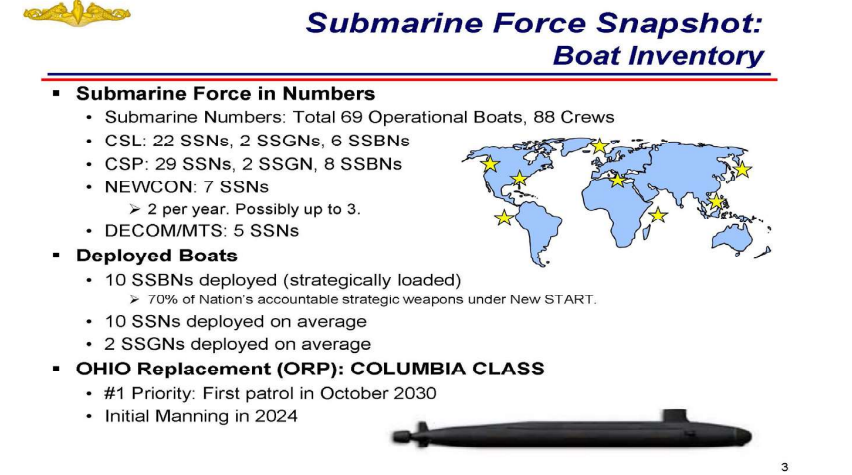
As Admiral Tofalo talked about in his speech yesterday, we pivote’d to the Pacific years before President Obama announced that pivot. As you can see right here, that’s our laydown in the Pacific right now. At any one time we have about 10 SSNs and two SSGNs deployed and 10 SSBNs strategically loaded providing up to 70 percent of that strategic weapons load under New START.
As Admiral Jabaley just talked about, we’re already starting to look at manning requirements and whether or not you realize it we have already assessed the Junior Officers that will be commanding officers of Ohio Replacement. So that’s the timeline we’re looking at. As Admiral Jabaley talked about, his timeline is 2030-2040. We’re there or earlier when we talk about manning.
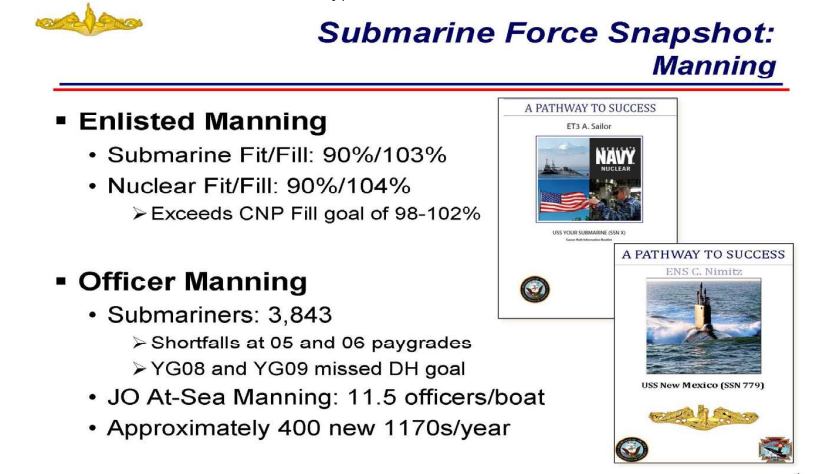
I’ll give you a quick snapshot of the submarine force overall in manning. I’d say we’re very healthy. You had a chance to listen to the Chief of Naval Personnel earlier and a lot of the Junior Officers on the panel, but a quick overview. Enlisted submariners right now, we man about 21,436 Sailors in the Submarine Force. Our ships are manned over 100 percent of the billet demand signal, that’s what we call “fill,” and we have the right Sailor with the right rank at the right fit about 90 percent of the time, which is really above what the rest of the Navy is able to achieve right now.
On the officer side, our 3,800 submarine officers make up about 15 percent of the unrestricted line, and about seven percent of the total officer corps. So as you’ve heard Admiral Caldwell and Admiral Tofalo talk about, we really are a lean force here in the submarine community. We still do have some shortfalls, especially in the control grades, what we call the 04 to 06 level.
So right now, if you look at 05, our authorizations what Congress allows us to have is about 316. We currently have 300, not bad, but when you add in all the billets that I’m required to fill that aren’t necessarily discretely coded for a submarine, surface, aviator, or SEAL, that puts the deficit up to about 174 commanders.
In the 04 level, we’re authorized 636. We have about 606 in in ventory right now. When you add those additional not discretely coded billets on top of that, we’re down about 165 lieutenant commanders.
At the 06 level we’re down about 50 O6s right now. So we do continue to emphasize retention at the mid and high level of the Submarine Force, and I work that on a daily basis in my role in PERS-42. As an aside, we bring about 400 new officers into the Submarine Force every year.
We are retaining our JOs at the right numbers. I’ll talk to you a little bit about that in a future slide. At sea, we have an average of 11.5 JOs per ship. If you’re in an extended refueling overhaul or you’re a deploying boat, you may get a little bit of a plus-up from that, but on average we are programmed for nine and we’re filling the submarines with a little over 11 right now.
Look at our career path for the Submarine Force. This doesn’t look very different from what you all have seen in the past if you were a sub mariner. We do offer many different opportunities right now for some JOs, which I’ll talk about in a future slide.
But we did make some modifications to our JO tour length about a year ago where we pulled the opportunity for those Junior Officers to take the Prospective Nuclear Engineering Exam, or PNEO, which is one of our crucible events as a Junior Officer to be qualified as an engineer and serve the Navy in the future, to the left. We did that for several rea sons.
We wanted to maximize the amount of time that Junior Officers had onboard their submarine after they had completed all of their qualifications, so they could focus on the ship driving and tactical proficiency and the ability to become more proficient at that next level in their sub marine career.
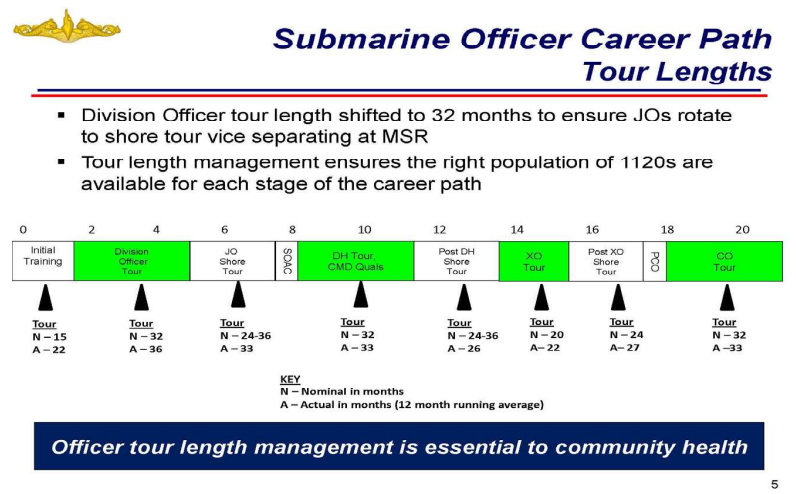
We have seen a very good return on investment in that area, especially when talking with many of the commanding officers in the Fleet. They’re really taking advantage of that opportunity to have those Junior Officers take that PNEO exam earlier. Sometimes they take it even as soon as 14 months after reporting to the ship, especially if they have prior enlisted experience or they’re a very sharp, hot running JO, as we like to say.
It also provided us another advantage by allowing that officer to take that exam a little earlier. We can look at rolling some of the top per forming JOs off of their first submarine tour at about the 32-month point, which is what we’re shooting for right now. That does several things. It allows me to get them to shore duty because, as I tell my commanding officers in the Submarine Force right now, I can guarantee you that a JO that doesn’t go to shore duty is not going to go to Department Head. So we need those JOs to go to shore duty.
I’ll give myself as a personal example. When I finished my first sea tour, I was not quite ready to go off and be a Department Head. I needed a little bit of time away from the ship to experience shore duty and get my family planning in line.
I had some good mentoring and I encourage you to talk about Junior Officer retention, for those of you that are retired. You still can serve as mentors for many of your former Junior Officers and department heads. I know many of you do that.
I’ve had periodic mentoring sessions with Admiral Walsh and Admiral Donnelly many times. I’ II tell you, when it came time for me to make a decision to go to SOAC (Submarine Officer Advanced Course), it was since I have the microphone I won’t put Admiral Walsh on the spot, I don’t know if he’s still here, but I can tell a good story.
I’ll give you one of two choices and you can figure out how Admiral Walsh handled it with me. The one choice is he kind of put his arms around me, hugged me and tried to convince me to go back to shore duty. The other option was he called me, and he used some flowery language. He said, what are you doing? Why aren’t you going back to be a Department Head? I was kind of one of those guys that needed a kick in the butt.
I ended up going back as a Department Head. I use that story as just kind of an anecdote that every Junior Officer is different. In PERS-42, we provide them with many different options when they go to shore duty so that they can make the informed decision as to whether or not they want to go back to be a Department Head.
Continuing on in the career path, there are a couple of differences when you go to post-Department Head shore tours, especially if you’re a non engineer served officer versus an engineer served officer, because we have to manage the talent on the submarines both at the Executive Officer and Commanding Officer level as far as who has been an engineer served officer.
We do have to maneuver timing around a little bit on some officer shore duties, but all in all, all officers get at least an 18-month shore duty between sea duties unless they opt to go back sooner. Some officers, especially in the Junior Officer world, will get a 36-month shore tour following their JO tour if they follow some of the more unique career paths.
I’d also like to end on this slide by saying our Commanding Officer tour lengths have remained relatively constant over the last decade, right at about the 32 to 34 months point. That’s compared to our brothers and sisters in the surface community that average about 18 months in their Commanding Officer tours, and aviators that manage about 14 months for their Commanding Officer tours.
Flipping forward to the career paths that I was talking about for JOs that we made flexible, as I alluded to earlier, some Junior Officers have the opportunity to take a 36-month shore tour. That allows us to give them the option to look at unique career opportunities following their first sea tour. Some JOs opt to go to a prototype, and some JOs opt to take the opportunity to go to a pre-commissioning unit.
Those precommissioning units, as Admiral Jabaley was talking about earlier, are in Norfolk or Groton. That allows some home port stabilization time for those Junior Officers and allows them to really get in on the ground floor of the building process of those submarines where they really get to know how that submarine is built and operates, so that in the future we can get some return on the investment in that officer when they come back as a Department Head, Executive Officer or Commanding Officer. They really know the Virginia-class down to the keel block.
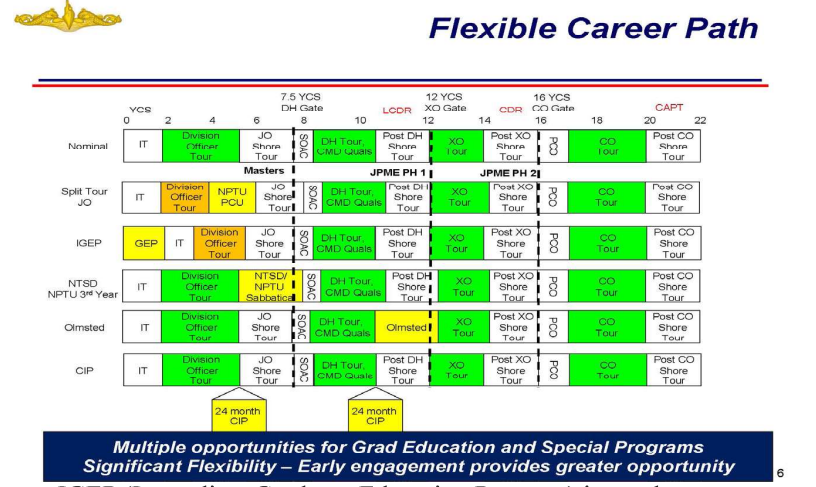
IGEP (Immediate Graduate Education Program) is another opportunity for intermediate level education. As Admiral Donnelly said, I’m a product of this program and I had the great pleasure of going to the Applied Research Lab at Penn State for two years, and I thoroughly loved that. The JOs that opt to do the nuclear power training unit tours or even some that do the pre commissioning unit tours, we give them an opportunity to take what’s called a sabbatical, and they can do a third year after they finish their two years of prototype or their 18 months in a pre commissioning unit, and they can use that to get a Master’s degree or to concentrate on their joint professional military education.
We also have Olmsted scholars, and CNP talked about some of these, in limited numbers, but it is a great opportunity. Part of the Sailor 2025 Initiative that CNP mentioned earlier is the Career Intermission Program (CIP). It’s small numbers right now, but this program allows an officer to temporarily leave the Navy for family planning purposes. We even have the opportunity to open that up for those that want to take a full two years and get a Master’s degree on their own time, to take a step out of their uniform, freeze their lineal number and not have to worry about promotion, and then come back in two years later.
Right now, it’s really small numbers for us in the nuclear fleet, both in the surface and submarine world where we have one surface nuke and one submarine officer using the Career Intermission Program. Overall, we have about 20 quotas Navy-wide for the program. I expect it will grow in popularity as Sailor 2025 continues to mature.
Looking at promotion and screening opportunities for our submarine officers, it really is following along historical averages. In general, if you have command of a submarine it gets you to captain. If you ‘re a served Executive Officer, you promote to commander, and if you completed a Department Head tour you promote to lieutenant commander. I will highlight lieutenant commander is generally the toughest cut for us in the Submarine Force, as it is for the other unrestricted line communities.
What we have really tried to manage in the distribution world for the Submarine Force is ensure our Junior Officers that are coming off of those shore tours that I described in a previous slide get to their Sub marine Officer Advanced Course or the Department Head course at the seven and a half year point of service. That ensures that those officers have a FITREP as a Department Head when they go before the 04 board.
So we’re competing against surface officers who are very similar right now in their career path to us. Serving in a Department Head assignment at sea when they’re going up for 04, it becomes very competitive. These models are a little bit different, but overall, I would say that we have competed very well in the tough 04 boards.
As part of the recent change to the manpower world, the Chief of Naval Personnel removed what used to be called zone stamps off our records. These zone stamps would notify the board as to what look an officer was on, either for promotion or for selection to Executive Officer or Commanding Officer. Those zone stamps are removed now, and it allows the board to take a look at an officer based on his or her ability and not seniority.
I will highlight, as a result, you may look in the lower right-hand corner of this slide and see that we had a sharp uptick last year in lieutenant commander promotion rates in the Submarine Force. That is because last year we promoted 22 lieutenant commanders below zone, which is unheard of in the Submarine Force. In the previous decade I can count on one hand how many 04s we promoted below zone.
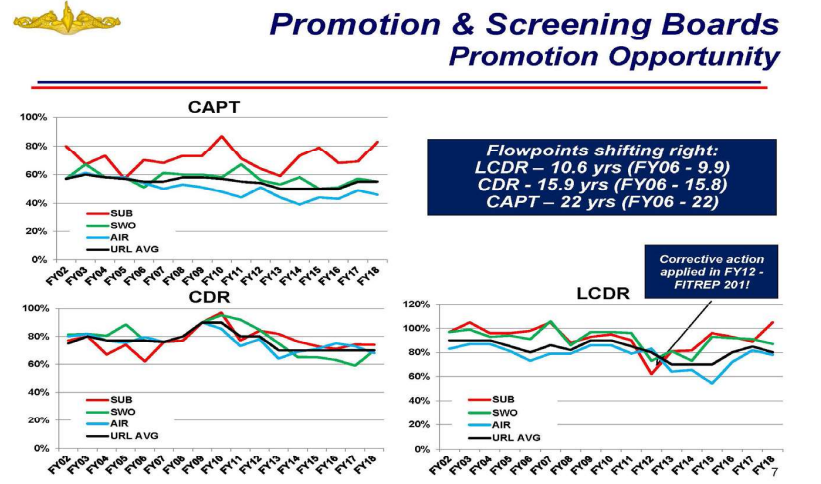
As a comparison, the surface community promoted 15 below zone and the aviators promoted 37 below zone. But if you remember back to my earlier slide, we only make up about 15 percent of the unrestricted line, so 22 compared to even 37 for the aviation community, we’re punching above our weight in the Submarine Force when it comes to promotions right now. We are, though, in the end still seeing some of those low points to promotion zones, shifting slightly to the right, most notably at the 04 level.
If I go on to screening board opportunities, these are administrative boards the Submarine Force holds within our own community to look at officer selections for Department Head, Executive Officer and Commanding Officer. We’re still doing well and tracking along historical averages. Department Head screening is something that was introduced back in 1995. In most years it’s an all qualified category. So if you meet all of the qualification requirements to be a Department Head, in general you have screened Department Head.
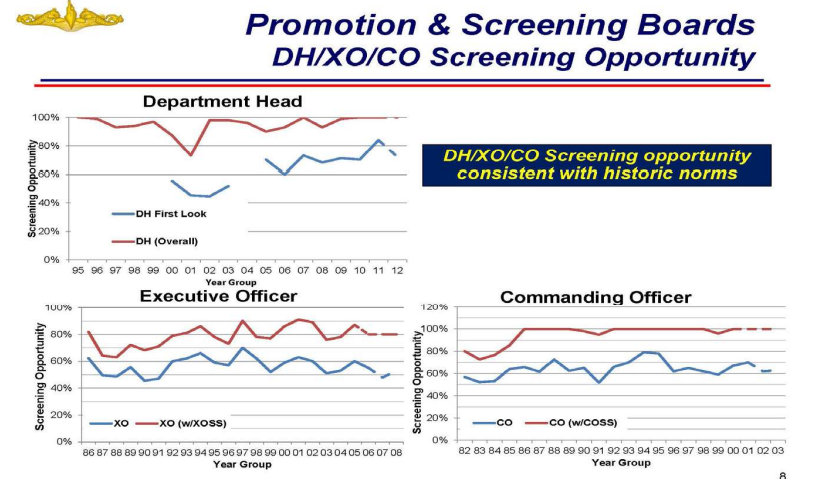
We do have a first look and a second look category for Department Heads, but all in all it does not really matter as far as what the assign ability of that officer is in the future to Department Head or Executive Officer or Commanding Officer. For XO screening, those officers get a look at their 9, 10 and 11 years of commissioned service, and their promotion rates are 30 percent for their first look, 50 for their second and 20 for their third. The same rates occur for Commanding Officers, they’re just at the 14, 15 and 16 years of commissioned service.
You’ll see two different lines on those graphs for the Executive Officer and Commanding Officer slides. The red lines show what the pro motion rate is if you include both officers that are screened for either Executive Officer or Commanding Officer, and those that are screened for what we call Executive Officer Submarine Support or Commanding Officer Submarine Support, XOSS or COSS. These are, in essence, officers that are fully qualified to be an Executive Officer or a Commanding Officer, but we just don’t have a boat in inventory for them right now.
So we will detail, for example, a COSS officer through the same pipeline that we make our Commanding Officers go through. That includes three months at Naval Reactors, three months at the submarine command course, and then two weeks at our leadership course. They end up serving as a deputy at one of our submarine squadrons basically in a pool available to be called up to serve as the Commanding Officer of a submarine. The same thing applies for the Executive Officers, with the exception that they don’t go through the Naval Reactors course.
Overall, historically, we call up about nine of the XOSSs per year and about six of the COSSs per year. So it is a very upwardly mobile path still, and we have many officers that have started as an XO or COSS and then are promoted up from there.
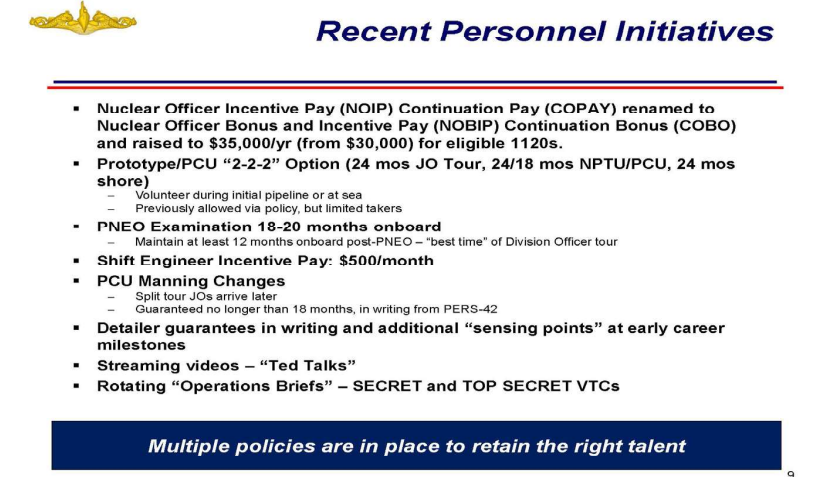
I won’t dwell too much on some of these recent personnel initiatives.
CNP talked about some of the later ones, but for the Submarine Force in general we raised our bonus to $35,000 last year. That puts us across the board at $35,000 for the surface nuclear officers as well as the submarine nuclear officers. We did that, as I talk about in a future slide here, based on a strong economy and some years where we just barely missed retention at the Junior Officer level.
We’ve instituted a couple of other of the non-traditional shore duty paths for some of our Junior Officers to allow them, while they’re even in the training pipeline, to choose to go to an operational submarine for two years and then go back and either go to a PCUs or prototype, and then go to a shore duty. This allows us to have volunteers for some of those more tough assignments like PCUs and prototype.
Because the shift engineer billets at NPTU’s down in Charleston and up in Ballston Spa, New York, have traditionally been difficult ones for us to fi II, just based on the nature of rotating shift work for some of our officers on shore duty, we recently started an initiative where those officers receive $500 extra a month to serve in those billets.
We have seen a sharp return on investment in that. As Admiral Tofalo mentioned in his speech, we went the last five Junior Officer slates, for over a year now, without having what we call a red detail or an officer that had a choice of his shore duty that was not in their top 10 preferences. So in the past year, we have had more volunteers for prototype than we have had spots to put them in, and we hope to continue that trend.
We also used some detailer guarantees to help us make retention numbers, as well as to afford opportunities for those Junior Officers who go to shore duty and do those tough jobs for us in PCUs and NPTUs. Some of those involve platform selection as a Department Head or even a home port guarantee for their Department Head assignments.
The last thing I’d say is that during the PNEO examination day at Naval Reactors, we actually provide quite a bit of detailing opportunities to those JOs, and we talk to them up there. We have started recently, as a result of one of our JO symposiums, which I’ll talk about here in a little bit, to offer updates to Junior Officers on what’s going on around the fleet. This affords an opportunity for a Junior Officer that has been serving on a ballistic missile submarine, to get a brief at the Secret or Top Secret level of what our submarines are doing in the Western Pacific AOR. As an example, next week we’ll actually provide a brief to the Junior Officers at Naval Reactors on how we do undersea rescue, an area that was near and dear to my heart at Squadron 11.
I talked a little bit about Junior Officer retention already. I’ll just highlight some on this slide. You’ll see in the upper left hand corner, as I talked to earlier, we did miss retention goals in year groups 08 and 09, but that was only by one or two officers.
Year group 10 is the year group that we’re focusing on right now. As you can see in the upper right hand corner, we have 115 officers retained as Department Heads, and our goal is 116. We still have 33 that are undecided, so I think we have a decent shot to get that last officer to make our goal for year group 10. The remaining year groups continue on track, but it is something we watch closely, especially with the economy continuing to be red hot.
I talked a second ago about the JO symposium. It was one of the initiatives that my predecessor Admiral Houston stood up as a result of a look at the retention rates in year groups 08 and 09. But before we went in to do a JO symposium, we analyzed the results of a submarine JO survey. I’ II throw the quick JO survey results up on the board, and you can compare JO survey results from 2007, which was the last survey we did, to 2016.
We had a much better return on our survey inputs from Junior Officers in 2016 than we did in 2007. But I would say that a lot of the same dissatisfiers, if you want to put it that way, are similar from 2007 to 2016 as far as what’s influencing Junior Officer resignations from sea. So about half the reasons, as you can see on the left, are really the nature of
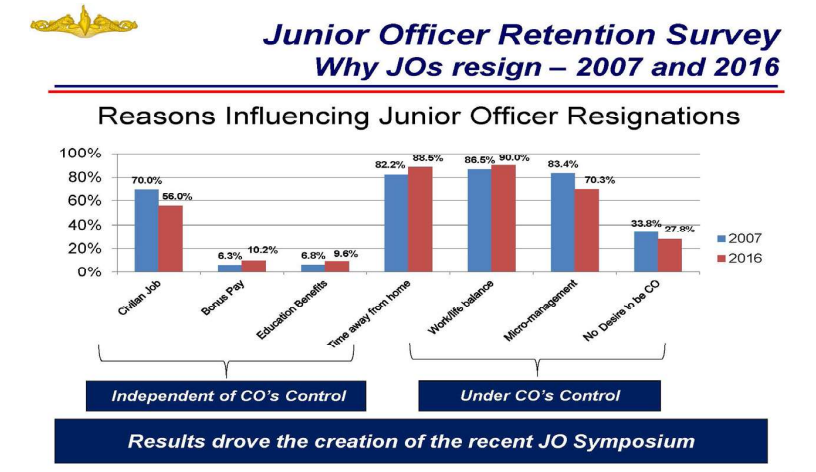
being a worldwide deployed operational force. The others are things we can and should go after. It is one of the areas that I work very closely with N97, Admiral Caudle and Admiral Tofalo on.
We did take what we learned from the JO survey and we put it into the topics that we addressed with our Junior Officers at our first ever JO symposium that we held in 2016 in San Diego. We had about 25 Junior Officers. I won’t say we hand picked those Junior Officers, but we looked for Junior Officers that were well respected in their home ports, because we brought Junior Officers in from all over, even those in the shipyard and those in the nuclear power training units as well. We had them come to San Diego for two days and we brought up many of the dissatisfiers that came out of the JO survey and we asked for additional ones from them on things we could do better.
I listed many of the lines of effort on the slide that we tried to take on. As you can see, we went all in on this JO symposium. I had a chance to sit in the back and listen to what the JOs had to say, and I can tell you that we, as you saw earlier on this panel, had an amazingly talented group of Junior Officers. I’m glad I don’t have to compete with them nowadays.
But they did ask us to make some changes, especially in the detailing world, and we took that on. We became a little more transparent in the
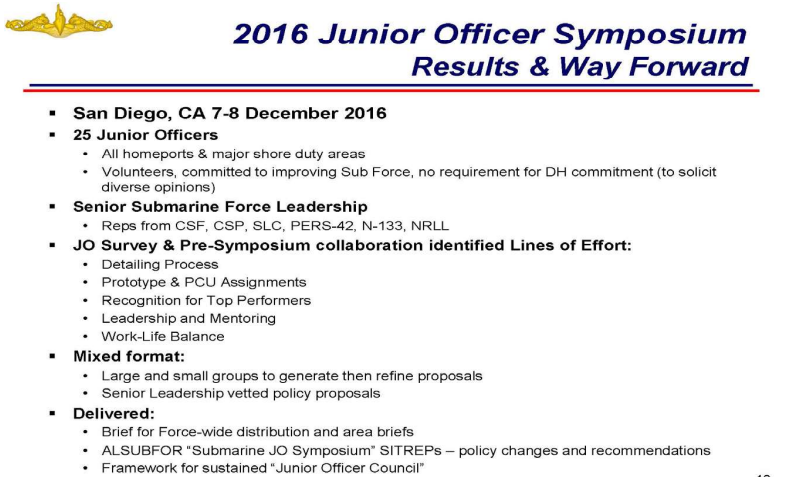
way we do detailing for Junior Officers, and I would say that it is really a benefit to us, as you can see by the numbers of Junior Officers we have playing slates right now. For the last two slates I actually had more Junior Officers that wanted to play to go to shore duty than we had jobs for. I had more volunteers for prototype than I had prototype jobs for.
I’ll add that we’re already knee deep in the planning for our next Junior Officer symposium, which we’ll hold in the spring of 2018. I al ready have the head of the next year’s JO Symposium, Lieutenant Ariana Pybus, working with me. She is currently underway on USS Georgia on her shore duty. She’s assigned as a LNO to the SEAL detachment in Norfolk, Virginia, and she has already reached out to a network of Junior Officers. We’re going to start to grade our homework on how we did on the lines of effort from our last JO symposium and what can we do to get better in the future.
One of the areas that the JOs were very excited about was Sailor 2025. I won’t talk too much about this, I’ll just highlight a couple of the ones that I’m pretty excited about and I think we’re going to get a significant return on investment from in the future. The first is the SECNAV tours with industry.
I’ve had a chance to talk personally with several of the officers that have already gone through the SECNAV tours with industry, one at Oak Ridge and one at GE Digital. We’re now looking, as those officers start the SECNAV tour with industry pipeline, to bring them to our type commander offices in either N4, N8 or N6 depending on the industry they’re going to go work with, and then stop them by the Pentagon to talk with N97 as to what they can do to help the Navy in their tour. Then we’re going to start looking at putting them in jobs that will benefit the Navy with the experience they gained in the commercial sector. For instance, we just recently placed an officer who finished his SECNAV tour with industry, GE Digital, in the N80 office in the Pentagon.
Naval post graduate school is one that I continue to beat the drum on. I know that there’s some exhibits upstairs of many in the post graduate school who had a great deal to get a graduate education opportunity in Monterrey. We’re already well above the number of naval post graduate school officers that are going this year, even compared to last year. The last one I’d mention is the Fleet Scholar Program. This is probably
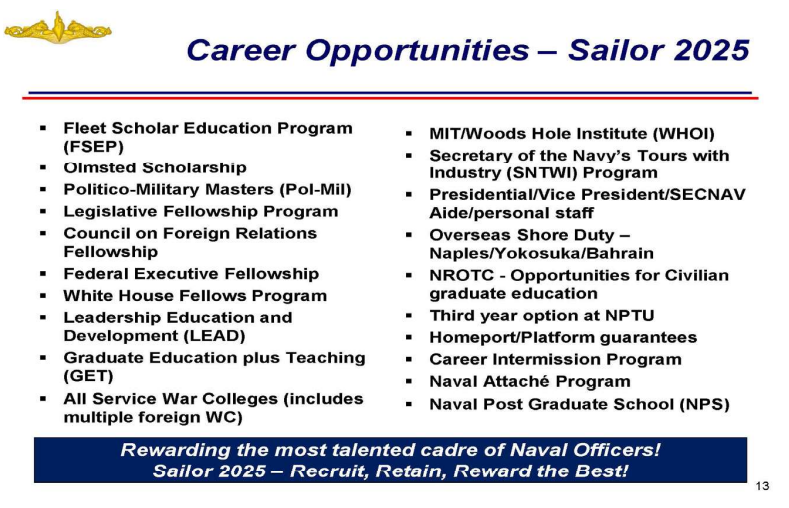
the most prized of the Sailor 2025 Initiatives within the submarine community right now. This gives Junior Officers an opportunity to choose a school. The Navy will pay for their graduate education, especially if it’s in a discipline that we can use.
Some of those are varied. MBAs really help us, for those that want to go in the acquisition community. So this last year we selected four of probably our best and brightest officers to go to places like the Kennedy School and Wharton.
I’ II just highlight that we have over 130 graduate education opportunities in residence right now for our post Junior Officers on shore duty. Forty percent of the jobs that Junior Officers fill on shore duty allow them an opportunity to get a dedicated in resident graduate school degree, which is the highest of any unrestricted line community right now.
I’m going to phase in here and talk briefly about submarine gender integration. I know we’ve had many talks on that, but I would say that it has gone very well. The enlisted integration on Michigan is complete. We just had an opportunity to out brief our flag officer leadership on how the integration has gone. We’re taking those lessons learned, as we’re already now starting to integrate on Florida.
We have 25 enlisted women on Florida already. Michigan is complete. Overall, we have 82 enlisted women in the submarine service right now. The rest of the stuff up there has already been highlighted by Admiral Tofalo before, so I’ll skip over and shift gears to nuclear Limited Duty Officers.
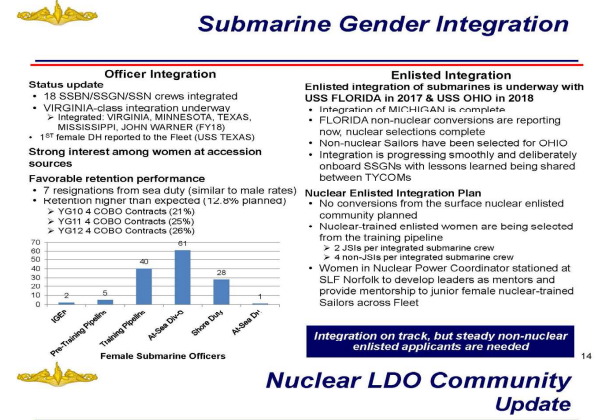
The Limited Duty Officer community as a whole is pretty near and dear to my heart. I had an opportunity to serve with some real top shelf
LDOs during my time on Jimmy Carter, Squadron 11, and through my times on submarines in interfacing with the maintenance activities. But I will tell you that this is the community that I’m worried the most about in my job at PERS-42 right now. Several years of low accessions, which resulted in some manning shortfalls, especially in the mid-lieutenant to early lieutenant commander grades in the LDO community.
I’m spending significant time in this area right now, and we’re looking at ways that we can minimize gaps. We are having to prioritize sea duty manning over shore duty manning in this community. These LDOs are sourced from both the surface and submarine communities. We take about 60 percent of our E6, E7 and very small numbers of E8s from the submarine service to be nuclear LDOs, and the surface community con tributes about 40 percent of the same rates.
But combined with some low accessions, the dis-establishment of the Chief Warrant Officer (CWO) community about four years ago which I came up with that idea so I’m kicking my own butt right now and the continued growth in the Virginia-class has really caused a little bit of a divot in our LDO manning. So we have gotten after this problem by changing the application process for LDOs that come out of the nu clear field. It’s much simpler. It’s down from about 14 sections to two now.
We have a new board. We will convene our first one in about a week and a half in Memphis, which we will use submarine, surface nuclear and aviation nuclear, carrier CO officers, to sit that board and choose our next generation of nuclear LDOs. I’m happy to say that already we have over a 100 percent increase in the number of applications for the nuclear LDO community this year. We’re up at about 200, so we have a very good cross section that can keep this community healthy in the future as we go forward.
Talking about the training pipeline, I’m going to spend the last part of my brief talking a little bit about the enlisted side, and I’ II wrap up. The nuclear power training units are going to go through a transition in mid-’19 to mid-’20 where we forecast we’ll be down to just two training platforms. As a result, we’ve already started to get ahead of that by dialing down/up enlisted accessions.
In fiscal year ’18 we reduced accessions by 440. In fiscal year ’17, we plussed it up about 220. Then in fiscal year ’19, although not
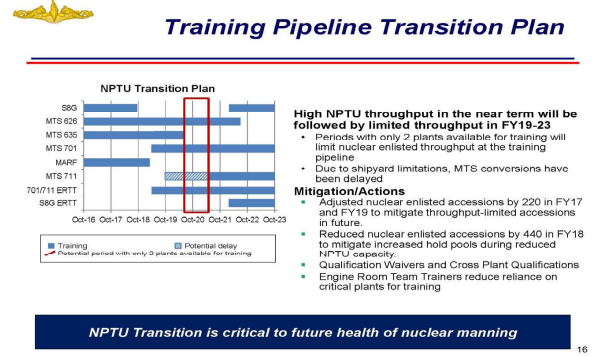
approved, we forecast we’ll bring back that divot by adding another 220 accessions. What that really does is it prevents accumulating a large hold pool of students during the period of time from mid-‘ 19 to mid-’20 when we’re down two training platforms. Ultimately, at the completion of this transition, we’ll have three reactors and three engine room team trainers that Admiral Caldwell alluded to earlier in his brief.
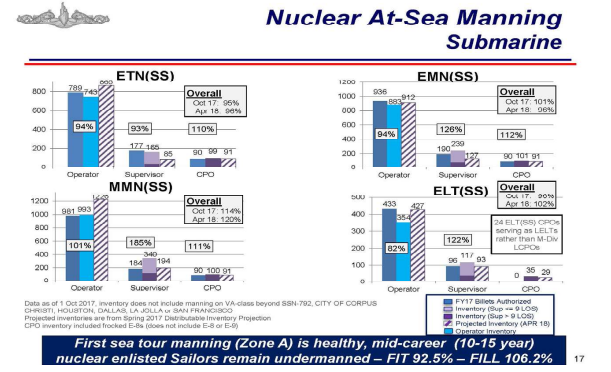
The last couple of slides here on nuclear at-sea manning, as I mentioned earlier we’re very healthy overall in the nuclear enlisted at-sea manning. Our fill is over 100 percent and our fit, even in our most con strained ratings, is at about 92 to 93 percent. What this graph is really meant to show you is it can kind of be an eye chart and very complicated it breaks it down to our four enlisted ratings.
It shows you that the dark blue is the billets that were authorized, and the light blue is how many we actually have onboard in the Navy that are qualified as an operator. In the hashed area is what we project that inventory to be in the next six months.
That’s for the operators. For supervisors, those are the Sailors that are generally greater than nine years of service in the Navy, although an operator can get a supervisory NEC at sea after just four years onboard the ship. You can see that overall, we tend to be pretty healthy across the board in all those areas.
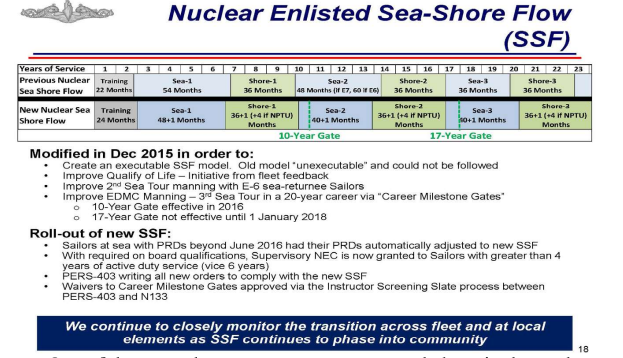
One of the areas that we were most concerned about in the nuclear enlisted community for all of our ratings is that second sea tour for our Sailors. One of the actions that we took about two years ago was to re vamp what’s called sea shore flow. This is, for all intents and purposes, the nuclear enlisted career path.
What we did was we shortened the first sea tour from 54 to 48 months, and the second sea tour from 48 to 40 months. What that really did was allow for an increase in quality of life for those first tour Sailors to get back to shore duty, just like we do with our JOs, give them the opportunity to look at re enlisting. And as a secondary benefit, it also allowed us to have those Sailors that were qualified as an EDMC actually have time in their career path to go back for a third sea tour and serve as anEDMC.
The prior career path actually was enabling those enlisted Sailors that had qualified and been promoted to E8 and were ready to go EDMC to retire before serving as an EDMC. The flow point was at the 18-and a half year point and they didn’t have the full time to make it back to sea before their 20 year retirement if they wanted to do that. So I’m pulling this sea tour to the left.
We’ve actually gotten a third sea tour out of many more of our Sailors and our EDMC inventory increased by about 40 available EDMCs just upon the delineation of this process right there. And then if you look even further out, we even have the ability now to get a second EDMC tour out of a select number of our senior enlisted Sailors. Right now, we have about 90 EDMC billets in the fleet and about 10 percent of them are second tour, preferentially to the pre-com missioning units and the SSGNs.
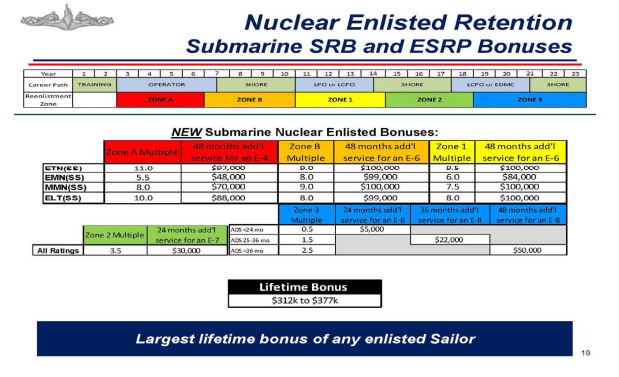
So I’ll end on what I think is a good note. When it comes to the enlisted community, as you can see on the bottom there, the typical nuclear enlisted Sailor can get a lifetime bonus of about $312,000 to $377,000. We’re the only community and when Force Davenport was my CMC at Squadron 11 he was always very jealous of this but it is the only community that continues to provide bonuses for Sailors well past their 20 years of service.
In fact, I have one caveat to add on there. We even provide our ES nuclear Sailors that go and serve at our prototypes an additional pay per month that’s equal to the pay that the Master Chief Petty Officer of the Navy’s (MCPON) gets. So our Sailors are pretty well compensated in the Navy. They do a very tough job, but we look at this very closely every six months to make sure we can use this as a lever to influence retention in the key rates that we need it.
So with that, I’ll open the floor to any questions.

